lies like truth: November 2009 Archives
 During one of the brief entr'acte pauses in yesterday afternoon's performance of Otello at San Francisco Opera, an elderly lady sitting close to me said to her friend: "The sets look cheap. But at least they're not skimping on the singing."
During one of the brief entr'acte pauses in yesterday afternoon's performance of Otello at San Francisco Opera, an elderly lady sitting close to me said to her friend: "The sets look cheap. But at least they're not skimping on the singing."Coming from a rather prim-looking person with carefully manicured hair and a tidy suit, the directness of this comment made me want to laugh out loud.
But the lady actually made an astute point: SF Opera, like pretty much all the other arts institutions around here, has been going through some incredibly tough fiscal times of late. The company has been forced to reign in its spending and the main target areas of the cost-cutting strategy can easily be discerned from Otello.
The company does indeed look like it's been saving on visual spectacle, which to my mind isn't a bad thing. John Gunter's production design basically uses a single set -- a bare stage surrounded by several layers of simple wooden balconies with perforated walls through which Duane Schuler's atmosphere-underscoring lighting design casts shadows. In the final act, white sheeting covers up the wood and a bed is placed center-stage with drapery around it. That's about it. There are no expensive revolving sets or very complicated set changes.
The sets look slightly tacky, it's true. But I would much rather have a bare stage and excellent acting and musicianship than terrible performances and pretty special effects. In this respect, SF Opera does audiences proud.
Otello has become a signature role for the South African tenor Johan Botha, who has performed the role at the Met, Vienna State Opera and Frankfurt Opera. Botha is massive in bulk, but he nevertheless manages to convey the Moor's delicate mental state. He rampages through the schizophrenic highs and lows of his character with fiery bravura and wounded pride. Marco Vratogna's serpentine Iago is a force of nature. Verdi grants this character some of the most melodious arias in the opera and the Italian baritone cruises slickly through every note, thus making his character as likable as he is evil. As Desdemona, Zvetelina Vassileva is like a beam of light. The Bulgarian soprano's unadorned approach to her character's arias pluck at the heartstrings. Though her lower register is lacking in color and power (a shame as quite a bit of Desdemona's part sits low in the voice) the radiance of the upper echelons cuts through darkness that enshrouds her scenes with Otello.
It's great that SF Opera isn't skimping on talent. On the other hand, it would be more interesting to see the company experiment a little more. An emphasis on rolling out the big guns -- singers who've been tried and tested in roles before -- over creating interesting new matches between singers and roles, or maybe even putting someone entirely fresh under the spotlight, speaks of too much safety at the expense of creativity. And the 2009-2010 season's heavy emphasis on warhorses of the Italian repertoire similarly underlines the company's anti-risk strategy.
I can understand what's motivating these decisions of programming and casting. They make a lot of sense in this economic climate. And as I mentioned above, at least the company is maintaining a high quality in terms of performances. But it would be great to see a little more risk taking, even in these risky times.
...Here's a list of five cultural activities to make the holiday weekend more holiday-like:
 The Great Dickens Christmas Fair
The Great Dickens Christmas Fair
Now 30 years old, a Bay Area favorite yuletide tradition returns to Cow Palace.
Through December 20, Cow Palace, San Francisco
http://www.dickensfair.com/
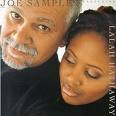 Joe Sample and Lalah Hathaway
Joe Sample and Lalah Hathaway
The jazz pianist/composer and vocalist reunite for three not-to-be-missed performances.
November 27 - November 29, Yoshi's, Oakland
http://www.yoshis.com/oakland/jazzclub/artist/show/1044
 The Bald Soprano
The Bald Soprano
Thank the Gods of absurdist performance that the Cutting Ball Theater Company's slick production of Eugene Ionesco's mad classic has been extended.
Through December 12, Exit on Taylor, San Francisco
http://www.cuttingball.com
 Sing-a-Long Sound of Music
Sing-a-Long Sound of Music
Don your lederhosen, wave your eidelweis and climb every mountain as The Castro Theater screens this family favorite.
November 27 - November 29, Castro Cinema, San Francisco
http://www.castrotheatre.com/p-list.html#nov25
 Ari Marcopoulos - Within Arm's Reach
Ari Marcopoulos - Within Arm's Reach
This mid-career retrospective of the Dutch-born, New York-based photographer captures New York's downtown art world, the emerging hip-hop scene, and hurtling snowboarders among other subjects.
Through February 7, The Berkeley Art Museum, Berkeley
http://www.bampfa.berkeley.edu/exhibition/marcopoulos_2009
 The Great Dickens Christmas Fair
The Great Dickens Christmas FairNow 30 years old, a Bay Area favorite yuletide tradition returns to Cow Palace.
Through December 20, Cow Palace, San Francisco
http://www.dickensfair.com/
 Joe Sample and Lalah Hathaway
Joe Sample and Lalah HathawayThe jazz pianist/composer and vocalist reunite for three not-to-be-missed performances.
November 27 - November 29, Yoshi's, Oakland
http://www.yoshis.com/oakland/jazzclub/artist/show/1044
 The Bald Soprano
The Bald SopranoThank the Gods of absurdist performance that the Cutting Ball Theater Company's slick production of Eugene Ionesco's mad classic has been extended.
Through December 12, Exit on Taylor, San Francisco
http://www.cuttingball.com
 Sing-a-Long Sound of Music
Sing-a-Long Sound of MusicDon your lederhosen, wave your eidelweis and climb every mountain as The Castro Theater screens this family favorite.
November 27 - November 29, Castro Cinema, San Francisco
http://www.castrotheatre.com/p-list.html#nov25
 Ari Marcopoulos - Within Arm's Reach
Ari Marcopoulos - Within Arm's ReachThis mid-career retrospective of the Dutch-born, New York-based photographer captures New York's downtown art world, the emerging hip-hop scene, and hurtling snowboarders among other subjects.
Through February 7, The Berkeley Art Museum, Berkeley
http://www.bampfa.berkeley.edu/exhibition/marcopoulos_2009
Herewith, my three favorite artistic renderings of turkeys culled from the Web:



Happy Thanksgiving.



Happy Thanksgiving.
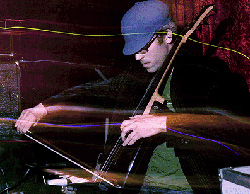 Cellos generally used to be found in orchestras and chamber music groups. But these days, the instrument seems to be appearing increasingly in other musical settings. And what's really interesting about the advent of the cello on the bluegrass, electronica, folk and rock scenes is that the instrument is being played like it's part of the percussion / rhythm section rather than the string section.
Cellos generally used to be found in orchestras and chamber music groups. But these days, the instrument seems to be appearing increasingly in other musical settings. And what's really interesting about the advent of the cello on the bluegrass, electronica, folk and rock scenes is that the instrument is being played like it's part of the percussion / rhythm section rather than the string section.At Berkeley's Freight & Salvage Coffee House folk club a few nights ago, I caught a gig by the brilliant alt-bluegrass band Crooked Still. The cellist for this ensemble, Tristan Clarridge, flicks his wrist near the bridge of his instrument and digs in with his bow to make a hard-edged sound that's rhythm-guitar-like and drives the pulse for the group. Clarridge plays his cello conventionally (ie with the instrument sitting between his legs). But the group's former cellist, Rushad Eggleston, played standing up, with his cello strapped around his shoulders like an enormous guitar.
Folk cellist Natalie Haas (who is best known for playing in a Celtic duo with fiddler Alasdair Fraser) plays her cello in a similar way to Clarridge. The music is of a different style, but the cello once again provides the kinetic-percussive drive of the sound.
In the world of electronica, Sam bass, cellist with Loop!Station, uses loop pedals, alongside vocalist Robin Coomer, to create a densely-structured soundscape. Cellist Alex Kelly, (pictured) who performs in a wide range of formats from alt rock concerts to hip-hop theatre pieces to circus performances, also uses technology like loop pedals to extend the creative capacity of his instrument.
Audiences are clearly amped about the ways in which these cellists are playing their instruments. Clarridge is perhaps the biggest draw in Crooked Still -- I was told by several people before and during the concert that he was the one to watch on stage. And one person I met was upset not to be sitting close enough to the Clarridge in order to be able to eyeball his technique properly. At a recent Mark Growden Sextet gig, in which Kelly plays, the cellist got a huge ovation.
It's exciting to see so many musicians exploring the possibilities for this instrument. Perhaps we'll start seeing more oboes and French horns being played in unusual contexts and ways soon too.
 I'm getting really tired of going to the theatre and witnessing plays that take pot shots at the most obvious people. Tony Kushner's series of rambling, politically-slanted short plays currently playing at The Berkeley Repertory Theatre, Tiny Kushner, suffers tremendously from this problem.
I'm getting really tired of going to the theatre and witnessing plays that take pot shots at the most obvious people. Tony Kushner's series of rambling, politically-slanted short plays currently playing at The Berkeley Repertory Theatre, Tiny Kushner, suffers tremendously from this problem.Don't you think it's time we got over making fun of Richard Nixon and Barbara Bush, Tony?
Berkeley audiences lap this stuff up of course. But left-leaning, west coast theatre audiences need shaking up. They don't need to have their egos and feelings massaged. I'd like to see more theatre that challenges the audience's liberal ideals in an intelligent way. Tiny Kushner merely reasserts lazy thinking.
Pictured: Kate Eifrig as the ex First Lady in Berkeley Rep's production.
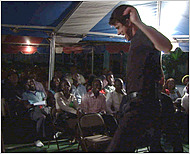 The San Francisco-based theatre artist Dan Hoyle's solo show about Nigerian oil politics, Tings Dey Happen, explores, among other provocative issues, the impact of visiting westerners on the lives of Nigerian locals. In response to what I wrote about the production in my weekly New York Times culture column on November 15, Hoyle evaluates his work and experiences as a white American conducting research for a theatre project in the Niger Delta.
The San Francisco-based theatre artist Dan Hoyle's solo show about Nigerian oil politics, Tings Dey Happen, explores, among other provocative issues, the impact of visiting westerners on the lives of Nigerian locals. In response to what I wrote about the production in my weekly New York Times culture column on November 15, Hoyle evaluates his work and experiences as a white American conducting research for a theatre project in the Niger Delta.
Tings Dey Happen deals explicitly with the impact that white people--even well-meaning white people--can have as foreigners in Nigeria. The decision to, As Ms. Veltman puts it, "take myself out of the play" was, I think, important to keeping the focus on the people I talked to, to ensuring that this was not just another play about a white guy in Africa. But totally removing my "shadowy presence" - again, Ms. Veltman's words -- would have been disingenuous. I was there, I was asking the questions. I don't portray myself as a character, but I use my search for answers as a narrative device--at its core, the play is, to use a cliché, a journey of discovery. It's about getting past the usual pity and guilt and trying, really trying, to understand Nigeria's people, its culture, and its politics. When the characters address my "shadowy presence," they are also addressing the audience--challenging them, as I was challenged.
But these criticisms are all valid enough, and I wouldn't be writing this response but for the suggestion that I've led my friend Williams (represented in the play as Okosi, a Delta militant) to give up his comfortable life as a killer, and that as a result he now lives a life of poverty. For it's not the whole story. Williams' life as a militant was not prosperous or even financially stable. He would have irregular paydays after participating in violent missions that would sustain him for several weeks, but he was still living in a wooden shack with no electricity or readily available fresh water, like everyone in his village. Williams' current life is hard, with less money, and he, like most Nigerians, struggles to get by every day. But when I talked to him on this most recent trip, Williams told me that he is happier now than when he was in the gang. He is happier for several reasons, but principally because he doesn't have to deal with the traumatic horror, guilt, and shame of participating in violence and killing. When I stayed in his shack in Nembe Creek, he would have violent nightmares that made him thrash around on the bed we shared at night. He still suffers from nightmares, he told me, but leaving militancy, and sharing his stories, "helps free my mind. And the only real freedom is in your mind."
Furthermore, I have worked to help Williams. When I left Nigeria in 2006, I introduced him to the new Fulbright Scholar in the Niger Delta, who introduced him to a prominent University of Port Harcourt professor who was able to get him a job offer. This didn't work out, but as people who have done this type of work before know, transitioning from a traumatic, unstructured life to the daily routine of regular work is not easy.
In Abuja last month, I helped arrange for Williams to meet with a Nigerian Senator. The Senator, Williams now tells me, has offered to pay for his University education. This is a great development, and I wait with fingers crossed, hoping that it works out. Just today Williams called me to say the Senator has given him the seed money to start this process. Additionally, while in Abuja last month, I suggested to U.S. Embassy folks that they arrange a speaking tour through the Delta in which Williams could tell his story and advocate for non-violence. They have connected him with various NGOs that could organize this kind of program. Other NGOs are eager to speak with Williams, having been impressed with the interview we did together for Africa Independent Television.
Going back to Nigeria to perform my play for Nigerians, and holding discussions with Nigerians, and giving interviews to Nigeria's media, and leading theater workshops for Nigerians--all this expanded and deepened my engagement with Nigerian society. Having come back to the US, to perform again for Americans, I have sought to share my fresh insights in the post-show discussions. But the message of the play remains the same: to understand Nigeria we must try, harder, to get past pithy analysis and see things as Nigerians see them. Only then will we be able to confront the true consequences of our presence in (or absence from) Nigeria.
Hoyle's show plays through November 29 at the Marines Memorial Theatre in San Francisco. Click here for tickets.
Also, you can read my original review of Hoyle's production for SF Weekly (published in January 2007) here.
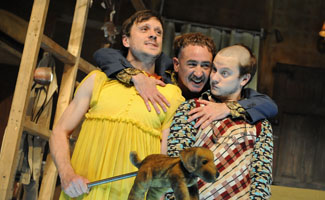 There are a few elements in Irish dramatist Enda Welsh's play The Walworth Farce -- currently on tour in the US in a Druid Theatre production directed by Mikel Murfi -- that might confuse or perplex American audiences. The reference to fish fingers (commonly known as fish sticks here) is one that leaps out.
There are a few elements in Irish dramatist Enda Welsh's play The Walworth Farce -- currently on tour in the US in a Druid Theatre production directed by Mikel Murfi -- that might confuse or perplex American audiences. The reference to fish fingers (commonly known as fish sticks here) is one that leaps out.After last night's performance at Zellerbach Playhouse in Berkeley was over, however, I ran into a British stage director friend who's been working on this side of the pond for the last three decades and we engaged in a short but lively discussion about the play and, more broadly, the subject of farce in America.
The director thinks that comedies like The Walworth Farce don't work out here because people don't understand farce like Europeans do. He says there's a tradition of slapstick in the U.S., but not farce, which is why, he claims, productions of plays by the likes of Martin McDonagh aren't as great in the US as they are in the Europe.
To illustrate his point, he mentioned's recent production of McDonagh's The Lieutenant of Inishmore, which he said was inferior to the London production which he experienced. The reason the London production was better, he said, was because the actors bought into the crazy circumstances of the play lock, stock and barrel and took the audiences along with them. They were completely immersed in the absurdity of the scenario. Whereas, in the States, he said, audiences and production teams can't quite go there. As a result, the actors on stage in Berkeley Rep's Inishmore were too "knowing" -- they were constantly indicating that they knew how how absurd the world of the play was through facial and body gestures as well as through the way they said some of their lines, therefore they created a bit of a comfortable distance between themselves and the play.
The difference between farce and slapstick is a subtle one. In one online dictionary, farce is defined as, "a light dramatic work in which highly improbable plot situations, exaggerated characters, and often slapstick elements are used for humorous effect." Slapstick is defined as, "a boisterous form of comedy marked by chases, collisions, and crude practical jokes."
I don't have European productions of McDonagh plays with which to compare the ones I've seen in the US. By and large, I've found myself to be completely immersed in the farcical worlds of these American-produced experiences though. So I'm not sure I wholeheartedly agree with my director friend, though he raises a fascinating point.
I actually think this nation is great at farce. The Matt Damon movie, The Informant! is steeped in farce, as are stage works by some of our local playwrights like Peter Sinn Nachtrieb and Aaron Loeb. Anyone who's seen productions of Nachtrieb's Hunter Gatherers or Boom, or Loeb's Abraham Lincoln's Big Gay Dance Party will know what I mean. And wasn't the Bush Administration pure farce?
 If a comet were to crash into the Earth, it would make quite a dent.
If a comet were to crash into the Earth, it would make quite a dent.But in director Ryan Rillette's production of Peter Sinn Nachtrieb's play Boom, this colossal event elicits more of a whimper than a bang on stage. This Bay Area premiere staging of the comedy which centers on a young biologist's madcap plan to save the human race by Marin Theatre Company misses a great opportunity to rock the audience's socks.
There are all kinds of ways directors, designers and actors can create a huge explosion on stage. The scenery could collapse, people could smack into each other or physically hurtle into the wings. Soot, cement dust or water could rain down. There could be blood. The lights could go crazy, as could the sound.
What we get in this production of Boom instead are some malfunctioning lights, a couple of bits of scenery coming unhinged and two actors collapsing (which they do throughout the show anyway.)
I hear from friends who saw versions of the play in New York and Seattle, that those productions made much more of the comet's impact.
How would you stage this scene?
 Artists are becoming very savvy about marketing themselves these days. Everyone's out there on FaceBook and MySpace and Twitter sending out news about their work and related upcoming events to generate interest and hopefully sell tickets.
Artists are becoming very savvy about marketing themselves these days. Everyone's out there on FaceBook and MySpace and Twitter sending out news about their work and related upcoming events to generate interest and hopefully sell tickets.So it's a little disconcerting to hear about artists who are not only unwilling to promote themselves but seemingly against the idea.
An exasperated arts presenter shared with me a story about a group of musicians who had done nothing to help her promote a concert she was hosting for the group at her venue. The group has no mailing list and no web presence. They didn't put the word out at all. Consequently, there were 40 seats filled in a venue that seats 450 for their concert the other day. What's worse is that many of the people who came to see the concert were invited guests of the artists on stage who all expected complimentary tickets.
Luckily, the group isn't typical of the artists that the presenter brings in. But it seems as if she needs to adopt a different strategy vis-a-vis this particular set of artists and others who may be equally or somewhat reticent about pitching in on the marketing front. If I were in her position, I'd probably do the following:
1. Allow each artist only two comps.
2. Tell them that they cannot perform at the venue again until they get a mailing list together and some kind of web presence, even if it's just a free blog on Blogger.
3. Tell them the audience needs to consist of at least 100 paying customers in order for them to see any return from the box office split.

More than any other recitalist I've experienced lately, Joyce DiDonato has far outstripped the rest in terms of knowing how to make a good end.
It wasn't just the mezzo-soprano's encore choices that touched the audience last night at Herbst Theatre in San Francisco, though they made for a magical sign-off. A showy Rossini aria ("Tanti Aaffetti In Tal Momento" from Donna Del Lago) followed by "Somewhere Over the Rainbow" don't sound like great choices. They seem like they'd be tacky, frankly. But DiDonato brought such good-natured feist to the Rossini and understated empathy to the Arlen-Harburg standard that these choices came over as the perfect way to send people home.
DiDonato is also masterful at ending individual songs in a powerful way. The conclusion of a couple of songs in a suite by the late 19th/early 20th century Spanish composer Fernando Obradors were particularly magical. In "Con amores la mia madre" the final cadence spiraled into the air like a butterfly taking off from a flower. "Del cabello mas sutil" ended with a gasp.
In every single piece, the performer demonstrated absolute and spell-binding control over her final note, sometimes decrescendoing incrementally to absolute silence over what seemed like an eternity, and at other times going out with a mighty bang or puff of smoke. She never fizzled.
It's no wonder that the Herbst audience -- normally so well versed in traditional concert hall etiquette -- didn't know quite what to do with itself after every song. There was often a breathtaking silence, followed by applause, even in the middle of a series or suite of songs.
When DiDonato finally exited after her final encore, she left her bouquet of flowers on stage. Just like the bouquet, the memory of her final notes lingers in my heart and will continue to do so for a long while hence.
It wasn't just the mezzo-soprano's encore choices that touched the audience last night at Herbst Theatre in San Francisco, though they made for a magical sign-off. A showy Rossini aria ("Tanti Aaffetti In Tal Momento" from Donna Del Lago) followed by "Somewhere Over the Rainbow" don't sound like great choices. They seem like they'd be tacky, frankly. But DiDonato brought such good-natured feist to the Rossini and understated empathy to the Arlen-Harburg standard that these choices came over as the perfect way to send people home.
DiDonato is also masterful at ending individual songs in a powerful way. The conclusion of a couple of songs in a suite by the late 19th/early 20th century Spanish composer Fernando Obradors were particularly magical. In "Con amores la mia madre" the final cadence spiraled into the air like a butterfly taking off from a flower. "Del cabello mas sutil" ended with a gasp.
In every single piece, the performer demonstrated absolute and spell-binding control over her final note, sometimes decrescendoing incrementally to absolute silence over what seemed like an eternity, and at other times going out with a mighty bang or puff of smoke. She never fizzled.
It's no wonder that the Herbst audience -- normally so well versed in traditional concert hall etiquette -- didn't know quite what to do with itself after every song. There was often a breathtaking silence, followed by applause, even in the middle of a series or suite of songs.
When DiDonato finally exited after her final encore, she left her bouquet of flowers on stage. Just like the bouquet, the memory of her final notes lingers in my heart and will continue to do so for a long while hence.
 ...is it possible to walk down the street swinging a yoga mat and be accosted by a homeless person pushing a Safeway cart in grimy clothes who says: "Pilates?" by way of introduction.
...is it possible to walk down the street swinging a yoga mat and be accosted by a homeless person pushing a Safeway cart in grimy clothes who says: "Pilates?" by way of introduction."No, yoga," I said to the man, smiling. I gave him a dollar. Then we went our separate ways.
 San Francisco is probably the most sexually tolerant city in the world. There are few places where people can walk around in nothing but socks and sneakers with bells dangling from their privates without getting arrested and San Francisco is one of them. Ironically, the fact that the city is so gay-friendly makes the latest work by the luminescent British physical theatre company DV8 so disturbing: It's eye-opening in this lovely, uber-liberal, open-minded bubble we live in to be reminded of just how much anti-gay sentiment still persists in the world.
San Francisco is probably the most sexually tolerant city in the world. There are few places where people can walk around in nothing but socks and sneakers with bells dangling from their privates without getting arrested and San Francisco is one of them. Ironically, the fact that the city is so gay-friendly makes the latest work by the luminescent British physical theatre company DV8 so disturbing: It's eye-opening in this lovely, uber-liberal, open-minded bubble we live in to be reminded of just how much anti-gay sentiment still persists in the world.Based on verbatim interviews and vox pops with people in the UK about their feelings towards homosexuality, To Be Straight With You delves into the personal experiences of gays and lesbians in many different communities and the hatred that society continues to have for what it considers to be a deviant "lifestyle" choice.
The production, directed by Lloyd Newson, begins straightforwardly enough, with little physical movement and a catalogue of verbal abuse culled from interviews directed against gays and lesbians. As the 80-minute-long production moves along, the physical side of the performance builds and builds through short episodic scenes that push a wide variety of movement vocabularies to their limits. In one of the most memorable scenes, a gay teenager skips rope with the grace of a hummingbird while describing the difficulty of coming out to his parents. The contrast between the performer's sustained bout of "extreme skipping" while talking with the ease of someone at rest is virtuostic and dazzling. The mad caricature of the idea of childhood created by the skipping is made sober by the down-to-earth talking.
Meanwhile, in another scene, an Indian muslim attempts to reconcile his religion and marriage with the fact that he has quiet relationships with men on the side. The performer's monologue is set to an amazing duet between two male performers featuring movement that pushes classical Indian dance technique to the extreme. In this scene, the monologist utters a line which to my mind captures the core tension at the heart of the work: "It is part of my nature but it is unnatural." This duality is underscored by the friction between the flowing, organic choreography and text of To Be Straight With You and its more freakish,violent and cartoonish side.
The visual and aural elements of the show, which include some very snazzy effects such as a transparent projected globe which one performer manipulates in a lecture-style to demonstrate the vast swathes of the globe where being gay will get you a prison sentence or worse, further arrest the senses. But DV8's presence in San Francisco for the first time in 12 years is electrifying not just from an aesthetic perspective. We might be living in 21st century San Francisco, but attitudes towards sexual orientation are still Medieval in many parts of the world. And I'm pretty certain that just below the surface even of this gay-friendly town, lurks intolerance and hatred.
 Here's a list of qualities that British theatre productions seem to think they need to possess in order to "succeed" in the U.S. market:
Here's a list of qualities that British theatre productions seem to think they need to possess in order to "succeed" in the U.S. market:1. A cast of actors, most of them speaking in middle-class Home Counties accents with just one or two "regional"-accented actors (e.g. a token Welshie or Scouser) thrown in for color.
2. Period costumes.
3. Live music, preferably played on period instruments.
4. Live animals on stage or beautifully-constructed puppets.
5. A bare-bones approach to scenery (it's all about the actors after all).
6. Shakespeare (or references to Shakespeare if not the performance of one of the Bard's plays.)
7. At least one comical septuagenarian actor with a neatly-trimmed beard.
8. Microphones.
 There's something to be said for the fact that retreat centres try to get the people who visit them to unplug for the duration of their stay. That's the whole point of going on a retreat -- to get away from the hustle and bustle of everyday life. But following an experience I had during a recent visit to the Esalen Institute at Big Sur, I'm wondering whether this attitude can go too far.
There's something to be said for the fact that retreat centres try to get the people who visit them to unplug for the duration of their stay. That's the whole point of going on a retreat -- to get away from the hustle and bustle of everyday life. But following an experience I had during a recent visit to the Esalen Institute at Big Sur, I'm wondering whether this attitude can go too far.I was sitting quietly in the dining room eating lunch while reading a book when one of the staff members at the Institute rudely came over and told me to put my book away. The reason? The book I was reading wasn't made of paper -- I was reading it on my iPhone and Esalen has a rule about not using computers at mealtimes.
I have great respect for the anti-laptop edict in general. Who wants to eat meals in a sea of computers with people clacking at keyboards, yakking on skype, IMing on FaceBook, checking their email and putting up screens between themselves and others? It's hardly very zen.
But if reading a book is allowed, as well it should be (and it is allowed at Esalen -- no one told me off when I whipped a paperback out at dinner the same day) then why should you have to read the words the old-fashioned way?
As more and more people start digesting text via Kindles, iPhones and other electronic devices, Esalen might have to take a less hardline stance on mealtime regulations vis-a-vis electronics. After all, reading and eating at the same time is one of life's great pleasures.
 "I've Got Nothing", the crowd-pleasing, "crowd-sourced" song created by the YouTube community under the auspices of four British teens, demonstrates just how easy it is to mobilize large numbers of people to create the kind of pop music product for free (well, for nothing but sweat equity) that was traditionally produced by a handful of professionals in a proper studio and with a sizable budget.
"I've Got Nothing", the crowd-pleasing, "crowd-sourced" song created by the YouTube community under the auspices of four British teens, demonstrates just how easy it is to mobilize large numbers of people to create the kind of pop music product for free (well, for nothing but sweat equity) that was traditionally produced by a handful of professionals in a proper studio and with a sizable budget.According to the BBC Chartjackers website (through which the project is being developed) the song came into being through the following process:
"The lyrics of the song are made up of YouTube comments, compiled into a song by another YouTuber. The lyrics were released and then YouTubers wrote a melody for the lyrics, and we picked our favourite. We held YouTube auditions via video response to pick the band, found the producer of the song through YouTube, and the music video is made up of literal interpretations of the lyrics, clapping and singing along, by YouTubers!"
I am pretty impressed with the result, I must admit. For a song that's been created by piecing together shards culled from the flotsam and jetsam of the Internet, it's a remarkably coherent piece of music. The "I got plenty o'nuttin'" / "one meatball"-type theme of the song is an old one. But it's one that everyone feels strongly about in the current economic climate. In the sunny key of G major, the music skips along, making the listener want to get up and dance. The tune is simple to sing. It mostly moves step by step and the refrain is catchy. The structure is a tried and true pop formula. There's even a short guitar break and a bridge passage. The song is sung as a duet by two sweet-voiced teenage Brits (a girl and boy) and generates extra goodwill by virtue of including a chorus of YouTubers singing along and clapping in the final refrain.
As saccharine as the thing is -- the video, which alternates between images of the singers skipping around London sharing ice-cream sundaes and cuddling an oversized teddy bear and snippets of YouTube footage, takes the sappy lyrics and boppy beats over the edge -- it gets right under your skin. I'd be quite surprised if "I've Got Nothing" doesn't make it into the higher echelons of the British pop charts as well as raises quite a bit of money for charity -- the project's two goals are to get into the Top 40 and generate funds for Children in Need.
I wonder if the same process could be applied as successfully to, say, a string quartet, opera aria, or piece for gamelan / steel drum band?
 Arts organizations try many different tactics to get young people through their doors, from offering low-cost tickets and organizing party nights with DJs to doing in-schools programs and partnering with other organizations that are more closely tapped into youth culture like capoeira clubs and skateboarding stores.
Arts organizations try many different tactics to get young people through their doors, from offering low-cost tickets and organizing party nights with DJs to doing in-schools programs and partnering with other organizations that are more closely tapped into youth culture like capoeira clubs and skateboarding stores.SF Playhouse has come up with what seems to me like a particularly straightforward way of inspiring the next generation of theatre goers. The company's new "Rising Stars" program provides sophomores and juniors from five different schools the opportunity to each see four plays from SF Playhouse's 2009-2010 season.
The funding structure behind the program makes a lot of sense: A group of SF Playhouse's regular subscribers (around 75 of them at the moment) each pledged an extra $100 on top of their annual subscription fees to cover the cost of one student's four tickets. In addition, the program director (SF Playhouse Lindsay Krumbein, who donates her time to the project) provides curricula for pre- and post-play lessons that focus on anything from theatrical devices to theme to set design.
The first group of students - from Impact Academy in Hayward and School of the Arts (SOTA) in San Francisco -- attended a performance of SF Playhouse's World Premiere The First Day of School on October 27. In addition to Impact and SOTA, Jefferson (South SF), Oakland School for the Arts, and Oakland Tech will join the program this year.
After each show, the students are expected to write a letter to their donor describing their experience with the play. At the end of the year, participants will all meet when the theatre gathers everyone together for a closing celebration. The company's goal is for each student to then take part in a second year of Rising Stars, seeing a total of eight plays in two seasons at SF Playhouse. The company hopes that the project will motivate the young people to develop a personal interest in theatre and seek out additional opportunities for theatre attendance and participation.
SF Playhouse producing director Susi Damilano told me the following about the impetus to start the program and the impact so far: "We started the program because we love kids. I have lots of nieces highschool age and none have gone to theatre before we began ours. And they LOVE it! We have been wanting to find an affordable way to get a program going and finally realized subscribers might be interested. Then came Lindsay who is donating time to put structure around the program. We hope to find grants to pay her, fund bart for the kids, and even increase numbers. The kids were so joyful, it was worth every penny."
Whether the students on the program end up being regular theatre goers remains to be seen. The SOTA students are already arts-centric, so I guess SF Playhouse already has a willing audience. But what personally appeals to me about this program is that it seems highly sustainable. The company is already producing high quality work and the funding model is simple: it draws on an already-established subscriber base and asks those subscribers to chip in a reasonable amount of money - 75 subscribers at $100 apiece generates $7,500. The theatre normally charges $40 per ticket, so the program covers close to 200 tickets, which is a good start. Given the paucity of arts education in schools around here right now, Rising Stars seems like it couldn't be more timely. It would be great to see other arts companies that have strong, established subscriber bases following SF Playhouse's lead.


 Three Bay Area-based dramatists had the following to say in response to this question:
Three Bay Area-based dramatists had the following to say in response to this question:Trevor Allen: "I don't chose to direct my own work anymore. I have been very fortunate to have been able to work with some amazing directors who "get" my weird plays (Kent Nicholson, Rob Melrose etc.) However, I also don't think there should be an immediate negative reaction to a playwright directing their own work. As long as they know what they are doing--directing a play that they happen to have written and not rewriting their play while trying to direct it at the same time. If they know the craft of directing, then more power to them!"
Mark Jackson: "As a playwright who quite often directs his own work, I of course think it's a good thing. But of course it's not for everyone. Some playwrights also have a knack for directing, and some do not. The garden variety con that usually gets mentioned is that a playwright would not have the proper objectivity to direct his or her own work. Again, I think this depends on the person and as a generalization does not fly as anything more than a seemingly logical theory. The garden variety pro is that, as the playwright, one has an invaluably intimate understanding of the play. Really, though, I think the question of whether or not playwrights should direct their own work depends on the individual, and so as a general question it is irrelevant. Should THIS playwrigt direct his or her own work? That is a question to ask, I think."
Peter Sinn Nachtrieb: "I haven't directed my own work since college, except for a few readings here and there. I think it's an admirable skill to be able to wear both hats at the same time and i think leads to the generation of work that can have a very strong point of view. For myself, especially when a play is new, I really enjoy just focusing on the writing, though I will give extensive notes and observations to a director. But I like not having to be the one responsible for managing those notes and tech and actor process. As "just the playwright" I can worry about my own part of the puzzle and then be able to take notes from my perspective . I also like how a director that's not me can expand my work and insert their own awesomeness. I like the wiggle room within a play's process, the particular combination of bodies in the room that ultimately shape how a final product will look. That being said, never say never. But I think if I do ever direct my work again in the future, I think I would pick a piece that I feel like I've really finished writing."
A bit about what each of these playwrights are up to right now:
Trevor's drama The Creature is playing at The Thick House under the auspices of Black Box Theatre Company.
Mark is currently in Germany co-directing a group-devised adaptation of Heinrich Heine's Deutschland, Ein Wintermärchen, commissioned by Schauspiel Frankfurt.
Marin Theatre Company is about to stage Peter's Boom. Peter is in Bloomington, Indiana right now visiting another production of the play at Cardinal Stage. In fact there are multiple productions of his plays going on right now around the country. Read Peter's blog to find out more.
 Finessing a sudden change in mood from comedy to tragedy and visa versa in the theatre is a challenging feat. I was reminded of this fact last night at a performance of Dominic Dromgoole's Globe Theatre production of Loves Labours Lost at Zellerbach Hall, Berkeley. The production is currently being presented under the auspices of Cal Performances as part of The Globe's current US tour.
Finessing a sudden change in mood from comedy to tragedy and visa versa in the theatre is a challenging feat. I was reminded of this fact last night at a performance of Dominic Dromgoole's Globe Theatre production of Loves Labours Lost at Zellerbach Hall, Berkeley. The production is currently being presented under the auspices of Cal Performances as part of The Globe's current US tour. Shakespeare's sophomoric 1598 comedy of love and wordplay has one of the trickiest temperature shifts in the dramatic cannon, when, in the final part of the play, the celebratory mood that pervades almost the entirety of the proceedings is suddenly broken by the announcement of the death of the Princess of France's father. Managing the about-turn from ecstasy to depression effectively can make or break a production of the play. To my mind, the change has to be extreme. If it feels half-hearted, the ensuing denouement and final weird song about the cuckoo leave the audience feeling puzzled rather than floored.
Unfortunately, the temperature bumped rather than plummeted in the hands of Dromgoole and his British cast. I felt a change in atmosphere in the room, but it felt relatively tepid, like an English summer day.
The scene before the shift was marked by an eruption of movement and hilarity that felt inorganic to the rest of the production, as if the director were purposefully setting up the big moment, rather than letting it catch us unawares. Actors ran around the stage for no apparent reason, and threw bits of baguette around.
When the messenger walked on stage to deliver the news, he stood out front so we could see him clearly. The cast took a while to notice him, with the princess herself being the last to stop bombarding the stage with bread. This created a lovely bit of dramatic irony, as the princess was the last to hear the news -- news that concerned her before anyone else on stage.
But somehow, the timing was off and the messenger's proclamation felt flat and stagey. The Princess' grief seemed real enough. (Michelle Terry is a wonderful performer -- I found her haughty-gamine Princess to be completely engaging throughout thanks to her lively physicality and sonorous speaking voice.) But the entire moment fizzled and the final cuckoo song, though quirky and melancholy, did not carry the weight of tragedy. The entire last 15 minutes of the production seemed more like a balloon slowly letting out air than one that went pop.
I wonder if Dromgoole might improve the staging of this final scene by listening to Mahler's Fourth Symphony, Mozart's Don Giovanni and pretty much any of Beethoven's symphonies? Mozart, Mahler and Beethoven are masters of sudden mood changes. Dromgoole could learn a thing or two from these guys.
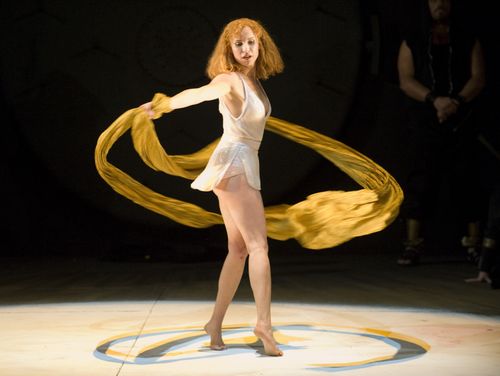 When headliner Nadja Michael (pictured) became "indisposed" last Friday for that evening's performance of Strauss' Salome at San Francisco Opera, stand-in soprano Molly Fillmore was flown in from Arizona at the last minute and hustled on stage.
When headliner Nadja Michael (pictured) became "indisposed" last Friday for that evening's performance of Strauss' Salome at San Francisco Opera, stand-in soprano Molly Fillmore was flown in from Arizona at the last minute and hustled on stage.Considering the fact that Fillmore, who is performing the role at Arizona Opera this month, had very little rehearsal time, she did a serviceable job, though the orchestra was too loud and it was quite often difficult to hear the soprano's voice especially in the higher part of her register.
If only Fillmore hadn't had to do any dancing.
Salome is not one of those "park and bark" operas, where a singer can get away with standing on stage more or less stock still or walk about a bit. There's a 20 minute exotic dance routine for the titular character right in the middle of the show. It's the pivotal moment of the story in fact: The princess wiggles lasciviously for the king and coaxes him into making her a rash promise that will cost him his kingdom.
I gather from Opera Tattler that Fillmore, though she had had an opportunity to rehearse the role with San Francisco Opera early in October, had not had much of a chance to learn the choreography. The dance, which in this production draws inspiration from early 20th century choreographers like Isadora Duncan, Ruth St Denis and Martha Graham, has some tricky moments in it, particularly involving the skillful manipulation of a variety of gauzy veils.
Fillmore moved awkwardly throughout. It was rather painful to watch her go through the motions. I was terrified that she was going to get herself tangled up in a veil or, worse, still, trip over her own feet. Plus, she lacked grace and lyricism, making the dance more clumsy than sexy. The twenty minutes went by agonizingly slowly.
I suppose it's mean-spirited of me to fault an underrehearsed performer who stepped up to the plate at such short notice. And it's not as if Michael had been earning raves herself in the role. Mark Swed of the Los Angeles Times reviewed the production on October 22 and had trouble with Michael's intonation, though he at least found her slightly more convincing in the part from a physical perspective.
But I won't forget Fillmore's Dance of the Seven Whales in a hurry, which isn't necessarily a good thing.
 Andrew Taylor's latest blogpost at ArtsJournal about "portfolio careers" in the arts got me thinking this morning about whether anything has really changed in the way that many people in the arts make a living, despite the terminology.
Andrew Taylor's latest blogpost at ArtsJournal about "portfolio careers" in the arts got me thinking this morning about whether anything has really changed in the way that many people in the arts make a living, despite the terminology.I first heard the term "portfolio career" applied to arts workers around 10 years ago when a management consultant friend of mine in London said to me, "it's pretty cool, you're portfolio lifestyle. I want one of those." At the time, I wasn't quite sure what he was getting at. I didn't consider my weird mixture of jobs -- which in 1999 consisted of working as the junior in the New York office of a big British daily newspaper, freelancing as a theatre critic all over the city, finishing up my masters thesis, moonlighting as a dramaturg for an underground performance art company and playing oboe and singing for a variety of semi-professional ensembles -- as being portfolio-like. I just thought of myself as muddling through until a "proper" job came along.
I had always been taught that you weren't really doing anything worthwhile unless you had a "proper" job, which consisted of going into an office and being paid, hopefully well, for steady work for a single highly-thought-of company over years and years, while gradually earning the favor of your superiors, rising to the very top and retiring at 60 to glory and grandchildren.
But I do remember thinking even back then that "portfolio" had a nice ring to it. The corporate tinge to the word made me feel important. Even though I wasn't really proud of what I was doing at the time, I started referring to myself as having a "portfolio career" at parties. People looked impressed. as time passed, I started feeling comfortable about my wheeling and dealing. I realized, despite the unpredictability of it all and decidedly shaky prospects, that it was the only way for someone like me to go. It still is.
Ultimately, it doesn't matter what you call making a living in the cultural industries. There isn't really any news here -- people in the arts (and many people in many other sectors too) have been functioning this way for a long, long time in all kinds of economies, both good and bad. "Portfolio career" means "freelancing" really, but it just sounds a bit grander.
 Even the most lighthearted and confident stars of the opera stage suffer from moments of unconscious stress. The bubbly American mezzo-soprano Susan Graham is currently in rehearsals with the Philharmonia Baroque Orchestra for a series of six concerts of the music of Henry Purcell. She's playing the legendary Queen of Carthage in Dido and Aeneas. The series begins at San Francisco's Herbst Theatre this Thursday before the artists take off to Palo Alto, Berkeley, Los Angeles and Davis for a couple of weeks.
Even the most lighthearted and confident stars of the opera stage suffer from moments of unconscious stress. The bubbly American mezzo-soprano Susan Graham is currently in rehearsals with the Philharmonia Baroque Orchestra for a series of six concerts of the music of Henry Purcell. She's playing the legendary Queen of Carthage in Dido and Aeneas. The series begins at San Francisco's Herbst Theatre this Thursday before the artists take off to Palo Alto, Berkeley, Los Angeles and Davis for a couple of weeks.Yesterday afternoon, while in conversation with Philharmonia Baroque's director, Nicholas McGegan, Graham -- a propos of nothing it seemed -- shared the contents of a nightmare she'd had the night before:
"I had a dream last night that I looked at my contract and it read that I had been engaged to sing not only the role of Dido but three other parts too." Graham's smooth, powered brow furrowed slightly at the unsavory recollection. But McGegan quickly ironed out the creases on his leading lady's face. "No, we're saving you just for Dido," he said, patting her shoulder. "There will be no costume changes for you. It's a one-dress show."
Blogroll
AJ Ads
AJ Blogs
AJBlogCentral | rssculture
About Last Night
Terry Teachout on the arts in New York City
Terry Teachout on the arts in New York City
Artful Manager
Andrew Taylor on the business of arts & culture
Andrew Taylor on the business of arts & culture
blog riley
rock culture approximately
rock culture approximately
critical difference
Laura Collins-Hughes on arts, culture and coverage
Laura Collins-Hughes on arts, culture and coverage
Dewey21C
Richard Kessler on arts education
Richard Kessler on arts education
diacritical
Douglas McLennan's blog
Douglas McLennan's blog
Dog Days
Dalouge Smith advocates for the Arts
Dalouge Smith advocates for the Arts
Flyover
Art from the American Outback
Art from the American Outback
Life's a Pitch
For immediate release: the arts are marketable
For immediate release: the arts are marketable
Mind the Gap
No genre is the new genre
No genre is the new genre
Performance Monkey
David Jays on theatre and dance
David Jays on theatre and dance
Plain English
Paul Levy measures the Angles
Paul Levy measures the Angles
Real Clear Arts
Judith H. Dobrzynski on Culture
Judith H. Dobrzynski on Culture
Rockwell Matters
John Rockwell on the arts
John Rockwell on the arts
Straight Up |
Jan Herman - arts, media & culture with 'tude
Jan Herman - arts, media & culture with 'tude
dance
Foot in Mouth
Apollinaire Scherr talks about dance
Apollinaire Scherr talks about dance
Seeing Things
Tobi Tobias on dance et al...
Tobi Tobias on dance et al...
jazz
Jazz Beyond Jazz
Howard Mandel's freelance Urban Improvisation
Howard Mandel's freelance Urban Improvisation
ListenGood
Focus on New Orleans. Jazz and Other Sounds
Focus on New Orleans. Jazz and Other Sounds
Rifftides
Doug Ramsey on Jazz and other matters...
Doug Ramsey on Jazz and other matters...
media
Out There
Jeff Weinstein's Cultural Mixology
Jeff Weinstein's Cultural Mixology
Serious Popcorn
Martha Bayles on Film...
Martha Bayles on Film...
classical music
Creative Destruction
Fresh ideas on building arts communities
Fresh ideas on building arts communities
The Future of Classical Music?
Greg Sandow performs a book-in-progress
Greg Sandow performs a book-in-progress
On the Record
Exploring Orchestras w/ Henry Fogel
Exploring Orchestras w/ Henry Fogel
Overflow
Harvey Sachs on music, and various digressions
Harvey Sachs on music, and various digressions
PianoMorphosis
Bruce Brubaker on all things Piano
Bruce Brubaker on all things Piano
PostClassic
Kyle Gann on music after the fact
Kyle Gann on music after the fact
Sandow
Greg Sandow on the future of Classical Music
Greg Sandow on the future of Classical Music
Slipped Disc
Norman Lebrecht on Shifting Sound Worlds
Norman Lebrecht on Shifting Sound Worlds
publishing
book/daddy
Jerome Weeks on Books
Jerome Weeks on Books
Quick Study
Scott McLemee on books, ideas & trash-culture ephemera
Scott McLemee on books, ideas & trash-culture ephemera
theatre
Drama Queen
Wendy Rosenfield: covering drama, onstage and off
Wendy Rosenfield: covering drama, onstage and off
lies like truth
Chloe Veltman on how culture will save the world
Chloe Veltman on how culture will save the world
visual
Aesthetic Grounds
Public Art, Public Space
Public Art, Public Space
Another Bouncing Ball
Regina Hackett takes her Art To Go
Regina Hackett takes her Art To Go
Artopia
John Perreault's art diary
John Perreault's art diary
CultureGrrl
Lee Rosenbaum's Cultural Commentary
Lee Rosenbaum's Cultural Commentary
Modern Art Notes
Tyler Green's modern & contemporary art blog
Tyler Green's modern & contemporary art blog
